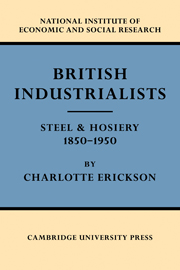Book contents
- Frontmatter
- Contents
- LIST OF TABLES
- Foreword
- Introduction
- I SCOPE OF THE INQUIRY
- II SOCIAL ORIGINS OF THE STEEL MANUFACTURERS
- III CAREERS OF THE STEEL MANUFACTURERS
- IV SOCIAL ORIGINS OF THE NOTTINGHAM HOSIERS
- V CAREERS OF THE HOSIERY MANUFACTURERS
- VI THE INTRODUCTION OF NEW TECHNIQUES IN STEEL-MAKING
- VII HOSIERY INNOVATORS
- VIII THE PUBLIC COMPANY
- Appendix A Selection of firms
- Appendix B List of firms included in steel study
- Appendix C Selection of men for steel study
- Appendix D The hosiery samples
- Appendix E Classification of fathers' occupations
- Appendix F Notes on comparisons with Population Census
- Appendix G Education
- Appendix H Marriages
- Appendix I Careers
- Appendix J Public company tables
- List of Principal Works Cited
- Index of names
- Index of companies
- General index
- PUBLICATIONS OF THE NATIONAL INSTITUTE OF ECONOMIC AND SOCIAL RESEARCH
VII - HOSIERY INNOVATORS
Published online by Cambridge University Press: 07 October 2011
- Frontmatter
- Contents
- LIST OF TABLES
- Foreword
- Introduction
- I SCOPE OF THE INQUIRY
- II SOCIAL ORIGINS OF THE STEEL MANUFACTURERS
- III CAREERS OF THE STEEL MANUFACTURERS
- IV SOCIAL ORIGINS OF THE NOTTINGHAM HOSIERS
- V CAREERS OF THE HOSIERY MANUFACTURERS
- VI THE INTRODUCTION OF NEW TECHNIQUES IN STEEL-MAKING
- VII HOSIERY INNOVATORS
- VIII THE PUBLIC COMPANY
- Appendix A Selection of firms
- Appendix B List of firms included in steel study
- Appendix C Selection of men for steel study
- Appendix D The hosiery samples
- Appendix E Classification of fathers' occupations
- Appendix F Notes on comparisons with Population Census
- Appendix G Education
- Appendix H Marriages
- Appendix I Careers
- Appendix J Public company tables
- List of Principal Works Cited
- Index of names
- Index of companies
- General index
- PUBLICATIONS OF THE NATIONAL INSTITUTE OF ECONOMIC AND SOCIAL RESEARCH
Summary
A select few of the Sheffield steel-makers, Lancashire engineers, and pig-iron producers of the north and west were responsible for the adoption of the Bessemer and open-hearth processes. Similarly in hosiery, most of the firms in the Nottingham industry as it functioned before the advent of the factory failed to follow the few who changed over to factory production in the decade after 1851. Little has been said about the primary and secondary iron and steel producers who never became heavy steel-makers or entered after the first ten years, except that this latter group contained some very great names in steel today. The method used in the study of the hosiery industry yields a detailed and comprehensive picture of the extent to which merchant hosiers in the Nottingham area participated in the introduction of factory organization and steam-powered machines.
Although none of the middlemen in the immediate vicinity of Nottingham took part in the introduction of the factory to the hosiery industry of that city, some of the merchant hosiers of Nottingham did. These merchant hosiers were the men whose origins and careers were discussed in chapters IV and V. Of the total of 113 merchant hosiers whose names were found in the Directory of 1844 and the Census of 1841, thirty-one individuals were partners in firms which later converted to factory production. The firms represented by this group are of greatest interest.
- Type
- Chapter
- Information
- British IndustrialistsSteel and Hosiery 1850–1950, pp. 171 - 187Publisher: Cambridge University PressPrint publication year: 1959



